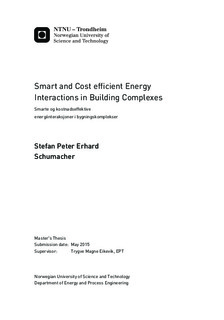Smart and Cost efficient Energy Interactions in Building Complexes - Smarte og kostnadseffektive energiinteraksjoner i bygningskomplekser
Master thesis
Permanent lenke
http://hdl.handle.net/11250/2350023Utgivelsesdato
2015Metadata
Vis full innførselSamlinger
Sammendrag
Efforts of the extension of new energy sources from renewable energies are motivated by the strategy of Energi21, which was published in 2014 by the Norwegian Ministry of Petroleum and Energy. The intention of this study is to fulfill the ambitions of the Energi21 strategy. The study is based on the building project in the Risvollan district of Trondheim, Norway. The building project includes a kindergarten, apartment building, assisted accommodation, care home and the existing Risvollan Center with shopping and healthcare floor.
An energy analysis based on the software program SIMIEN provides information about the expected heat and cold demand of the Risvollan buildings. Based on this energy analysis and the applicable technologies for covering the thermal energy demand of the buildings, three energy concepts are designed. Operation methods of each energy concepts are discussed and the system components are dimensioned.
Assessments of the energy efficiency of the three energy concepts are made. The energy efficiency ratios are decisive for the calculations of the expected annual costs. The Levelized Energy Costs (LEC) are made in order to compare the energy concepts from an economically point of view.
The conclusion of this study shows that all three energy concepts are able to meet the target of covering the Risvollan project buildings with sufficient thermal energy. The LEC analysis has shown that during the system lifetime of 25 years the higher investment costs of the exploitation of the renewable energy sources for producing thermal energy is advantageous compared to the purchase of external thermal energy.
